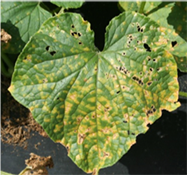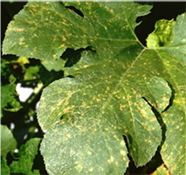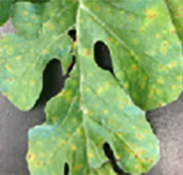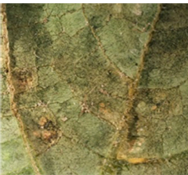The information provided below is current at this time. If any updates are made to the information below, the corresponding year in which the updates are made will be included in the publication title.
The water mold cucurbit downy mildew affects cucurbits (vine crops in the squash family) in South Carolina every year, especially in summer and fall. Downy mildew spreads quickly on cucumber, cantaloupe, and watermelon. Prevention before it appears, and prompt action afterward, are needed to manage this aggressive pathogen.
Symptoms and Signs
Leaf spots on cucumber (figure 1) or cantaloupe start as pale green to yellow, angular spots that turn brown. Leaf spots on squash and pumpkin (figure 2) are small, bright yellow flecks across the leaf surface that enlarge and turn brown. Symptoms on watermelon are quite variable. Sometimes spots are small and yellow, and in other cases, they are up to one-half inch wide, irregular, and brown (figure 3). Brownish-purple spores are found in patches on the bottom of infected leaves in the early morning (figure 4).
There are two strains of cucurbit downy mildew, strain 1 (old) and strain 2 (new).1 Strain 2 attacks cucumber, cantaloupe, and honeydew and is sometimes called the cucumber strain. Strain 1 mainly attacks squashes, pumpkin, and watermelon. It may infect cucumber and melons. Because it is the only strain that attacks squash, it is called the squash strain.
How Cucurbit Downy Mildew Spreads
Cucurbit downy mildew survives over winter on crops growing in southern Florida and Texas, where cucurbits do not freeze. In the spring, wind blows downy mildew spores northward from the South. Spores move farthest and fastest during cloudy, windy weather and can be blown over 600 miles in 48 hours! Cucurbit downy mildew can also be spread when diseased transplants are moved.
Outbreaks of cucurbit downy mildew are most likely to occur during mild, wet weather. Rainwater washes spores out of the air onto leaves. Rain, dew, or fog makes infection likely. After infection, downy mildew will continue to spread, even in dry weather, if temperatures stay above 60°F.
The Cucurbit Downy Mildew Forecast map (cdm.ipmpipe.org) shows where downy mildew has been reported in the current year. The site also predicts where spores will spread from known sources and where weather will be favorable for a new outbreak in the next 48 to 72 hours.
Cultural Practices to Limit Cucurbit Downy Mildew
Organic and conventional growers should take these steps to avoid downy mildew on their crops.
- Plant cucurbits early. Downy mildew is a greater threat to summer and fall crops than to spring crops. Crops planted as early as possible after the last predicted frost may not need to be treated with fungicides.2
- Choose cucumber varieties with resistance to downy mildew; see the Southeastern U.S. Vegetable Crop Handbook(com/).3 Downy mildew will develop slower on partially resistant varieties than on susceptible varieties. ‘Chaperone’ and ‘DMR-NY401’ are pickling and slicer cultivars with partial resistance.
- Summer squash, zucchini, and acorn squash tolerate some downy mildew. They still produce marketable fruit when they have downy mildew, so they do not need to be sprayed as often, and protectant fungicides might be enough.
- Trellising does not help manage downy mildew.4
Spraying for Cucurbit Downy Mildew
Fungicides are necessary to manage downy mildew on cucurbits grown in South Carolina in summer and fall.
- Along the coast of South Carolina, cucurbit downy mildew usually shows up after May 1. In the Midlands and Upstate, downy mildew usually appears after June 1. A preventive spray program with chlorothalonil or mancozeb (or copper for organic growers) is critical to delay development of downy mildew.
- Check the Cucurbit Downy Mildew Forecast map (ipmpipe.org). Add downy mildew-specific fungicides (table 1) to the spray program when downy mildew is found in or near your state.
- Once downy mildew appears in your field, spray on a 7-day schedule.
- Cucurbit leaves form a very dense canopy. High pressure (at least 50 psi) and high volume (at least 50 gpa) are needed once vines touch.
- Apply fungicides before a predicted rain rather than after it rains. To stick and work, fungicides must be dry on the leaves before rain starts.
Organic Production
In organic production, fixed copper fungicides help to prevent cucurbit downy mildew, but only if they are sprayed before infection.5
Prevention
Use program 1 in table 1 to prevent downy mildew in conventional production.
Table 1. Conventional fungicides recommended to prevent and manage cucurbit downy mildew.
|
|
Program 1: Prevent (Before symptoms appear) |
Program 2: Manage (After symptoms appear) |
|
| Tank mix with protectant* | |||
| No | Yes | ||
| Cucumber, cantaloupe | chlorothalonil, mancozeb, Zampro®, Elumin® | Orondis® Opti, Omega*, Gavel®, | Ranman, Presidio® |
| Watermelon, pumpkin, squash | chlorothalonil, mancozeb, Zampro®, Elumin® | Orondis® Opti, Orondis® Ultra, Gavel® | Ranman, Revus®, Presidio® |
* Note: 30-day pre-harvest interval on cantaloupe and 7-day pre-harvest interval on cucumber and squashes with Omega. Omega is not registered on watermelon.
Management
Once downy mildew has been found in a field, use different conventional fungicides to manage the disease. Spray three of the fungicides in program 2 (table 1) in rotation with each other. Rates and other details are in the Southeastern U.S. Vegetable Crop Handbook (www.vegcrophandbook.com).3
Fungicide Resistance
Rotate conventional fungicides to reduce the risk of fungicide resistance. Tank mixing fungicides specific for downy mildew with protectant fungicide also helps prevent fungicide resistance. Do not rotate Gavel® with Elumin® as both fungicides are in Fungicide Resistance Action Committee (FRAC) Group 22.
In most parts of the United States, both strains 1 and 2 of cucurbit downy mildew are resistant to Ridomil, Forum®, and FRAC Group 11 fungicides (Cabrio®, Quadris®, Flint®, Pristine®, and Reason®). The squash strain (strain 1) in South Carolina is resistant to Curzate®. Resistance to Previcur® Flex and Tanos®, Curzate® is also present in some strains and locations, so these fungicides are not recommended against cucurbit downy mildew in South Carolina.
Spraying Orondis® Fungicides
Orondis® products must be rotated with other fungicides recommended for downy mildew to lower the risk of resistance getting worse. Both the cucumber and squash strains found in Charleston, South Carolina, in 2020 and 2021 were less sensitive to Orondis®than they were in 2015.6
- Do not rotate Orondis® Opti and Orondis® Ultra with each other.
- Do not use Orondis® Gold to manage downy mildew.
- Orondis® Ultra (Orondis® + Revus® premix) is not recommended on cucumber, cantaloupe, or honeydew, because strain 2 is resistant to the Revus® component (table 2).3
Most importantly, the number of sprays with Orondis® fungicides is limited to one-third the total number of fungicide sprays per crop. This means if cucurbits are sprayed one to five times, an Orondis® fungicide may be sprayed only once. Orondis® fungicides may be sprayed twice if the total number of sprays is six to eight. In a fungicide program, Orondis® fungicides must be rotated with two other fungicides 1:1:1 (table 1).
Table 2. Special notes about Foliar Orondis products.
| Cucumber, Cantaloupe, Honeydew | Watermelon, Pumpkin, Squashes | |
| Orondis® Opti
(Orondis® + Bravo®) |
√ | √ |
| Orondis® Ultra
(Orondis® + Revus®) |
DO NOT USE | √ |
References Cited
- Rahman A, Standish JR, D’Arcangelo KN, Quesada-Ocampo LM. Clade-specific biosurveillance of Pseudoperonospora cubensis using spore traps for precision disease management of cucurbit downy mildew. Phytopathology. 2021 Feb; 111:312–320. doi:10.1094/PHYTO-06-20-0231-R.
- Keinath AP, Silva FD, DuBose VB, Zardus SH. Evaluation of seeding dates and fungicide application to manage downy mildew on slicing cucumber, 2021. Plant Dis. Manage. Rep. 2022;16: V073. https://www.plantmanagementnetwork.org/pub/trial/pdmr/reports/2022/V073.pdf.
- Kemble JM, senior editor. Albornoz K, Bertucci MB, Bilbo TR, Jennings KM, Meadows IM, Melanson RA, Rodrigues C, Rudolph RE, Wright-Smith HE, Walgenbach JF, Wszelaki AL, associate editors. 2025 Southeast U.S. vegetable crop handbook. 2025. vegcrophandbook.com.
- Keinath AP. Integrated management of downy mildew on slicing cucumber with fungicides and host resistance but not trellising. Plant Dis. 2019 Oct;103:2592–2598. doi:10.1094/PDIS-02-19-0323-RE.
- Marine SC, Newark MJ, Korir RC, Everts KL. Evaluation of rotational biopesticide programs for disease management in organic cucurbit production. Plant Dis.2016 Nov; 100:11, 2226–doi:10.1094/PDIS-02-16-0252-RE.
- Keinath AP. Reduced sensitivity of Pseudoperonospora cubensis clades 1 and 2 to oxathiapiprolin in South Carolina. Plant Health Prog. 2022. doi:1094/PHP-12-21-0148-SC.
Additional Resources
Keinath AP, Miller G. Watermelon fungicide guide for 2025. Clemson (SC): Clemson Cooperative Extension, Land-Grant Press by Clemson Extension; 2025. LGP 1001. http://lgpress.clemson.edu/publication/watermelon-fungicide-guide.





